Author: Author: Joseph L. DORRIS Date: 2014-9-13 20:14:24
These thicker zonestend to surround a miarolitic cavity.Pocket formation is largely structurallycontrolled in that the magma and accompanyingvolatiles collect in areas ofdirectional change (such as the lowermostcurvature of a pegmatite vein or along a fault line) where they subsequentlycrystallize and form cavities thatallow for the development of pegmatiticminerals. Comparatively, the linear pegmatitesrarely give rise to pockets.
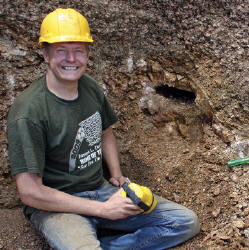
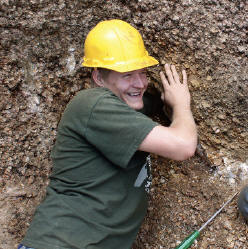
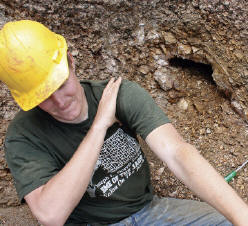
Lucky Monday pocket shows up for the first time, Tim is measuring it and showing how deep it is. Quality of the crystals is still unknown at that stage of work. J. Dorris photos.
The cross section of a typical pocketstarts from the country granite andgrades into an aplite contact region. Theaplite then grades into larger grainedgraphic granite. Next, the various pegmatiteminerals, chiefly feldspar andquartz elongate toward the pocket openingand terminate in euhedral crystalswithin the pocket.
Typical miarolitic cavities found atthe Smoky Hawk are approximately thesize of a watermelon with a large cavityreaching 60 by 60 by 30 cm high. The cavitiesare generally ovoid and extendalong the pegmatite, the floor beingsomewhat flatter than the ceiling. Rarely,miarolitic cavities occur in the more verticalpegmatite dikes.
Of the pegmatites encountered atthe Smoky Hawk, three are the main producingbodies. Each has produced wellover one hundred miarolitic cavities, approximately90% of which have containedsome amazonite and smokyquartz of varying quality. In comparison,other pegmatites within the Pikes PeakBatholith average two to three cavities,with only 10% containing smoky quartzand amazonite of generally lighter color.
When encountered, most cavitiesshow very little open space, almost neverhave crystals attached to the ceiling, andusually resemble a jumble of clay-coveredbroken aplite and pegmatite. Essentially,all the pockets forcefullyrupture shortly after primary crystallizationand continue to collapse due toweakened and deteriorating surroundingrock. Thus, when a pocket is opened,the first indications of its presence willbe increasingly larger pegmatite fragmentsuntil a rusty red or yellowish euhedralface of a promising crystal isencountered.
Overburden is usually removed bymechanized equipment but collecting within pockets is typically done withhand tools. The upper broken layers(breakdown) are systematically removeduntil the pieces of pegmatite, with attachedcrystals still pointing into thepocket (ceiling plates), are revealed.
These plates are then carefully pulledup, out, turned over, and hopefully revealsome incredible combination specimens.
Where possible, each section of thepocket is systematically collected, left side, center, right side, and so on. Theright side ceiling crystals are wrappedtogether and the right side bottom crystalsare wrapped together and thenplaced together in the same box. Thishelps keep sections in the proper proximityof each so that broken specimenscan be more easily reassembled.

Crystals show up on the ceiling of the pocket. J. Dorris photo.
All but a very few, probably lessthan 0.5%, combination specimens ofsmoky quartz with amazonite are not repaired.
Contacts between the crystalsare usually weak and the crystals easilyseparate along the contact planes. Addto this the double cleavage of feldsparand a high incidence of separated andcleaved crystals results. Therefore, thecrystals are often reattached to one anothermuch like the pieces of a jigsawpuzzle. Unlike the typical context of “repair”where a broken crystal has beenreassembled, most of the “repairs” onthe finer amazonite and smoky quartzspecimens are simple “fit repairs”.
The most demanding process beginsshortly after the pockets are collected.
The boxed specimens are removed fromthe field and taken to a lab where thethousands of pieces are carefullywashed. The pieces are then laid out inthe order they were taken from thepocket, where possible in rows, left sidetop and below it, left side bottom, and soon. Following this – depending on pocketsize – several months are invested infinding the missing fits and temporarily“repairing” the larger pieces.
After “fitting,” the best pieces areselected for the lengthy cleaning process.
Both chemical and mechanical meanshave been developed to remove the clayand Fe-Mn oxide overgrowths and stainingthat coat the crystals. At this point,it is often discovered that the Fe-Mn oxideshave penetrated the amazonite crystals.
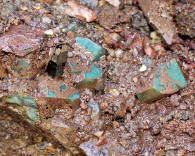
Amazonite and smoky quartz in situ. J.Dorris photo.
About half the pockets containspecimens that can never be satisfactorilycleaned and thus, are never broughtto market. Fortunately, some of the clayovergrowths and Fe-Mn staining is on thesurface and can be removed, allowingthe natural colors of amazonite andsmoky quartz to be revealed.










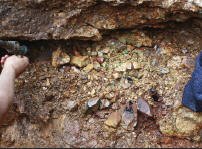
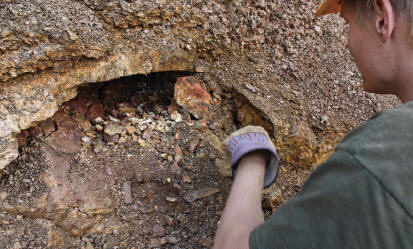

 YueGongAnBei 44051102000467
YueGongAnBei 44051102000467


 |
|